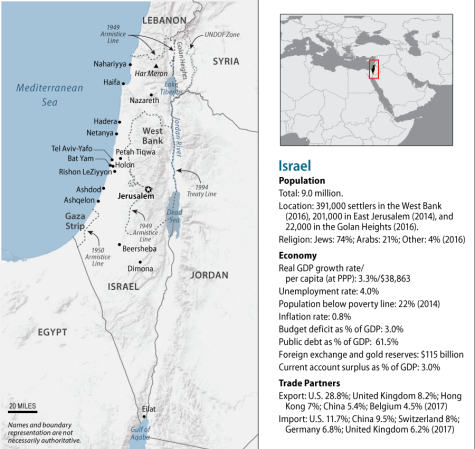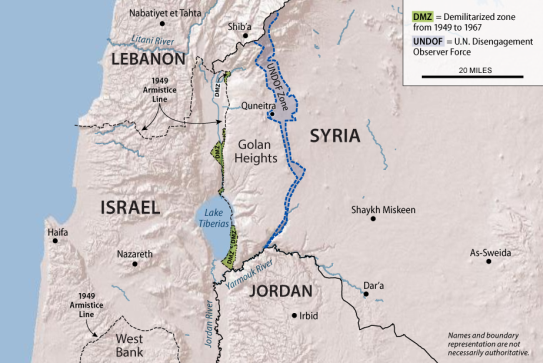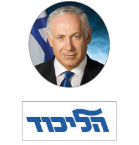Israel: Major Issues and U.S. Relations
Changes from April 8, 2019 to June 13, 2019
This page shows textual changes in the document between the two versions indicated in the dates above. Textual matter removed in the later version is indicated with red strikethrough and textual matter added in the later version is indicated with blue.
Israel: Background and U.S. Relations in Brief
Contents
- Introduction: Major Issues for U.S.-Israel Relations
- How Israel Addresses Threats
- Military Superiority and Homeland Security Measures
- Undeclared Nuclear Weapons Capability
- U.S. Cooperation
- Iran and the Region
- Iranian Nuclear Agreement and the U.S. Withdrawal
- Syria
- Russia
- Golan Heights
- Hezbollah in Lebanon
- Israeli-Palestinian Issues
- Recent Complicating Factors
- Diplomatic Prospects and Concerns
- April 2019 Elections and Other Domestic Issues
- Domestic Issues and September 2019 Elections
Summary
Strong relations between the United States and Israel have led to bilateral cooperation in many areas. Matters of particular significance to U.S.-Israel relations include
- Israel's ability to address the threats it faces in its region.
- Shared U.S.-Israel concerns about Iran and its allies on the nuclear issue and in Syria and Lebanon.
- Israeli-Palestinian issues.
- Israeli domestic political issues, including elections scheduled for September 2019.
Israel relies on a number of strengths to manage potential threats to its security and existence. It maintains conventional military superiority relative to neighboring states and the Palestinians. It also takes measures to deter, attack, and defend its population and borders from evolving asymmetric threats such as rockets and missiles, cross-border tunneling, drones, and cyberattacks. Additionally, Israel has an undeclared but presumed nuclear weapons capability.
Against a backdrop of strong bilateral cooperation, Israel's leaders and supporters routinely make the case that Israel's security and the broader stability of the region remain critically important for U.S. interests. A 10-year bilateral military aid memorandum of understanding (MOU)—signed in 2016—commits the United States to provide Israel $3.3 billion in Foreign Military Financing annually from FY2019 to FY2028, along with additional amounts from Defense Department accounts for missile defense. All of these amounts remain subject to congressional appropriations.
In recent months, U.S. officials have expressed some security-related concerns about China-Israel commercial activity.Israeli officials seek to counter Iranian regional influence and prevent Iran from acquiring nuclear weapons. In April 2018, Prime Minister Binyamin Netanyahu released new Israeli intelligence on Iran's nuclear program in April 2018,presented historical information about Iran's nuclear program that Israeli intelligence apparently seized from an Iranian archive. The presentation came days before President Trump announced the U.S. withdrawal from the 2015 international agreement that constrains Iran's nuclear activities. It is unclear whether Israel might take future military action in Iran if Iranian nuclear activities resume. Since 2018, Israel has conducted a number of military operations in Syria against Iran and its allies, including Lebanese Hezbollah. Israel and Iran also appear to be competing for military advantage over each other at the Israel-Lebanon border. Amid uncertainty in the area, in March 2019 President Trump recognized Israel's claim to sovereignty over the Golan Heights, changing long-standing U.S. policy that held—in line with U.N. Security Council Resolution 497 from 1981—the Golan was occupied Syrian territory whose final status was subject to Israel-Syria negotiation.
The prospects for an Israeli-Palestinian peace process are complicated by many factors. Palestinian leaders cut off high-level political contacts with the Trump Administration after it recognized Jerusalem as Israel's capital in December 2017. U.S.-Palestinian tensions have since worsened amid U.S. cutoffs of funding to the Palestinians and diplomatic moves—including the May 2018 opening of the U.S. embassy to Israel in Jerusalem. Palestinian leaders interpreted these actions as prejudicing their claims to a capital in Jerusalem and to a just resolution of Palestinian refugee claims. Israeli Prime Minister Netanyahu has welcomed these U.S. actions. The Trump Administration has suggested that it will release a proposed peace plan after Israeli elections, which are scheduled for April 9, 2019. Speculation continues about how warming ties between Israel and Arab Gulf states may affect Israeli-Palestinian diplomacy, though Saudi Arabia said that the U.S. policy change on the Golan Heights would negatively affect the peace process. Bouts of tension and violence between Israel and Hamas in Gaza have continued—reportedly accompanied by indirect talks between the two parties that are being brokered by Egypt and aim for a long-term cease-fire.
Domestically, Israel is preparing for the April 9 elections, which are closely contested. Former top general Benny Gantz is combining with former Finance Minister Yair Lapid to challenge Netanyahu, whom the attorney general has recommended be indicted for corruption in three separate cases. The elections and subsequent government formation process will have significant implications for Israel's future leadership and policies.
Domestically, Israel will hold another round of Knesset elections in September 2019, after Netanyahu was unable to form a government following April 2019 elections and the Knesset dissolved itself. The elections may come too late for a new Netanyahu government (if he wins) to pass legislation protecting him from indictment on three pending corruption charges. A pre-indictment hearing is scheduled to take place in early October.
Introduction: Major Issues for U.S.-Israel Relations
Strong relations between the United States and Israel have led to bilateral cooperation in many areas. Matters of particular significance include the following:
- Israel's own capabilities for addressing threats, and its cooperation with the United States.
- Shared U.S.-Israel concerns about Iran, within the context of the U.S. exit from the 2015 international nuclear agreement, and
growingtension involving Iran and Hezbollah at Israel's northern border with Syria and Lebanon. - Israeli-Palestinian issues
, including those involving Jerusalem, Hamas and the Gaza Strip, funding for Palestinians, and a possible Trump Administration peace plan. Israeli domestic political issues, including probable corruption-related indictments against Prime Minister Binyamin Netanyahu and closely contested elections that are scheduled for April 9, 2019and U.S. policy, including the Trump Administration's actions on political and economic matters to date. Israeli domestic political issues, including upcoming elections in September 2019 after Prime Minister Binyamin Netanyahu was unable to form a government in May, in the context of probable corruption-related indictments against Netanyahu, and debates regarding ultra-Orthodox military conscription and judicial checks on Knesset majorities.
For background information and analysis on these and other topics, including aid, arms sales, and missile defense cooperation, see CRS Report RL33476, Israel: Background and U.S. Relations, by Jim Zanotti; and CRS Report RL33222, U.S. Foreign Aid to Israel, by Jeremy M. Sharp.
How Israel Addresses Threats
Israel relies on a number of strengths to manage potential threats to its security and existence. These strengths include robust military and homeland security capabilities, as well as close cooperation with the United States.
Military Superiority and Homeland Security Measures
Israel maintains conventional military superiority relative to its neighbors and the Palestinians. Shifts in regional order and evolving asymmetric threats during this decade have led Israel to update its efforts to project military strength, deter attack, and defend its population and borders. Israel appears to have reduced some unconventional threats via missile defense systems, reported cyber defense and warfare capabilities, and other heightened security measures.
Israel has a robust homeland security system featuring sophisticated early warning practices and thorough border and airport security controls; most of the country's buildings have reinforced rooms or shelters engineered to withstand explosions. Israel also has proposed and partially constructed a national border fence network of steel barricades (accompanied at various points by watch towers, patrol roads, intelligence centers, and military brigades) designed to minimize militant infiltration, illegal immigration, and smuggling from Egypt, Syria, Lebanon, Jordan, and the Gaza Strip.1 Additionally, Israeli authorities have built a separation barrier in and around parts of the West Bank.2
 |
|
Sources: Graphic created by CRS. Map boundaries and information generated by Hannah Fischer using Department of State Boundaries (2011); Esri (2013); the National Geospatial-Intelligence Agency GeoNames Database (2015); DeLorme (2014). Fact information from CIA, The World Factbook; Economist Intelligence Unit; IMF World Outlook Database; Israel Central Bureau of Statistics. All numbers are estimates and as of 2018 unless specified.
|
Undeclared Nuclear Weapons Capability
Israel is not a party to the Nuclear Nonproliferation Treaty (NPT) and maintains a policy of "nuclear opacity" or amimut. A 2017 report estimated that Israel possesses a nuclear arsenal of around 80-85 warheads.3 The United States has countenanced Israel's nuclear ambiguity since 1969, when Israeli Prime Minister Golda Meir and U.S. President Richard Nixon reportedly reached an accord whereby both sides agreed never to acknowledge Israel's nuclear arsenal in public.4 Israel might have nuclear weapons deployable via aircraft, submarine, and ground-based missiles.5 No other Middle Eastern country is generally thought to possess nuclear weapons.
|
China-Israel Commercial Activity and Its Impact on U.S.-Israel Relations U.S. officials have raised some concerns with Israel over Chinese investments in Israeli high-tech companies and civilian infrastructure that could increase China's ability to gather intelligence and steal security-related technologies. For example, a state-owned Chinese company (the Shanghai International Port Group) has secured the contract to operate a new terminal at Haifa's seaport for 25 years (beginning in 2021), and another state-owned Chinese company (a subsidiary of China Harbour Engineering Company) is developing Ashdod's new port. Partly because of concerns about China, Israel 1969, when Israeli Prime Minister Golda Meir and U.S. President Richard Nixon reportedly reached an accord whereby both sides agreed never to acknowledge Israel's nuclear arsenal in public.12 Israel might have nuclear weapons deployable via aircraft, submarine, and ground-based missiles.13 No other Middle Eastern country is generally thought to possess nuclear weapons. |
U.S. Cooperation
Israeli officials closely consult with U.S. counterparts in an effort to influence U.S. decisionmaking on key regional issues, and U.S. law requires the executive branch to take certain actions to preserve Israel's "qualitative military edge," or QME.1314 Additionally, a 10-year bilateral military aid memorandum of understanding (MOU)—signed in 2016—commits the United States to provide Israel $3.3 billion in Foreign Military Financing and to spend $500 million annually on joint missile defense programs from FY2019 to FY2028, subject to congressional appropriations.
Israel's leaders and supporters routinely make the case that Israel's security and the broader stability of the region remain critically important for U.S. interests. They also argue that Israel is a valuable U.S. ally.1415 The United States and Israel do not have a mutual defense treaty or agreement that provides formal U.S. security guarantees.15
Iran and the Region
Iran remains of primary concern to Israeli officials largely because of (1) Iran's antipathy toward Israel, (2) Iran's broad regional influence,1617 and (3) the probability that some constraints on Iran's nuclear program could loosen in the future. In recent years, Israel and Arab Gulf states have discreetly cultivated closer relations with one another in efforts to counter Iran.
Iranian Nuclear Agreement and the U.S. Withdrawal
Prime Minister Netanyahu has sought to influence U.S. decisions on the international agreement on Iran's nuclear program (known as the Joint Comprehensive Plan of Action, or JCPOA). He argued against the JCPOA when it was negotiated in 2015—including in a speech to a joint session of Congress—and welcomed President Trump's May 2018 withdrawal of the United States from the JCPOA and accompanying reimposition of U.S. sanctions on Iran's core economic sectors. A few days before President Trump's May announcement, Netanyahu presented information that Israeli intelligence operatives apparently seized in early 2018 from an Iranian archive. He used the information to question Iran's credibility and highlight its potential to parlay existing know-how into nuclear-weapons breakthroughs after the JCPOA expires.1718 In his September 2018 speech before the U.N. General Assembly, Netanyahu claimed that Iran maintains a secret "atomic warehouse for storing massive amounts of equipment and materiel."1819 An unnamed U.S. intelligence official was quoted as saying in response, "so far as anyone knows, there is nothing in [the facility Netanyahu identified] that would allow Iran to break out of the JCPOA any faster than it otherwise could."19
After Netanyahu publicly exposed the Iranian nuclear archive, some former Israeli officials speculated about what action Israel might consider taking against Iranian nuclear facilities if Iran abrogates the JCPOA and expands nuclear activities currently restricted under the agreement.2021 However, Netanyahu had said in an interview that he was not seeking a military confrontation with Iran.21
Syria22
23
Periodic Airstrikes Against Iran-Backed Forces
Israel and Iran have engaged in hostile action over Iran's presence in Syria. In the early years of the Syria conflict, Israel primarily employed air strikesairstrikes to prevent Iranian weapons shipments destined for the Iran-backed group Hezbollah in Lebanon.2324 Later, as the Syrian government regained control of large portions of the country with Iranian backing, Israeli leaders began pledging to prevent Iran from constructing and operating bases or advanced weapons manufacturing facilities in Syria.2425 Since 2018, Israeli and Iranian forces have repeatedly targeted one another in and over Syrian- and Israeli-controlled areas.2526 In January 2019, Prime Minister Netanyahu said that Israel had targeted Iranian and Hezbollah targets in Syria "hundreds of times."2627 Limited Israeli strikes to enforce "redlines" against Iran-backed forces could expand into wider conflict, particularly if there is a miscalculation by one or both sides.
U.S. involvement in Syria could be one factor in Israeli calculations on this issue. The U.S. base at Al Tanf in southern Syria has reportedly "served as a bulwark against Iran's efforts to create a land route for weapons from Iran to Lebanon."2728 Israeli officials favor continued U.S. involvement in Syria, while also preparing for the possibility that they may need to take greater direct responsibility for countering Iran there.28
Russia
Russia's advanced air defense systems in Syria could make it more difficult for Israel to operate there. Since 2015, Russia has operated an S-400 system at Russia's Khmeimim air base in Lattakia, a city on Syria's Mediterranean coast. To date, however, Russia does not appear to have acted militarily to thwart Israeli air strikes against Iranian or Syrian targets, and Israel and Russia maintain communications aimed at deconflicting their operations.
In addition to the S-400 that it owns and operates, Russia delivered an S-300 air defense system for Syria's military to Khmeimim airbase in October 2018. The delivery followed Syria's downing of a Russian military surveillance plane in September 2018 under disputed circumstances, shortly after an Israeli operation in the vicinity. According to an Israeli satellite imagery analysis company, three launchers appeared to be operational as of February 2019.29 It is unclear to what extent Russia has transferred the S-300 to Syrian military control, and how this might affect future Israeli military action in Syria. An Israeli journalist wrote that "Israel has the knowledge, experience and equipment to evade the S-300, but the fact that additional batteries, manned by Russian personnel, are on the ground, will necessitate greater care [when carrying out future operations against Iran-aligned targets in Syria]."30 Since the September 2018 incident, Israeli air strikes appear to have decreased somewhat.31
Golan Heights
On March 25, 2019, President Trump signed a proclamation stating that the United States recognizes the Golan Heights (hereinafter, the Golan) to be part of the State of Israel.3230 The proclamation stated that "any possible future peace agreement in the region must account for Israel's need to protect itself from Syria and other regional threats"3331—presumably including threats from Iran and the Iran-backed Lebanese group Hezbollah. Israel gained control of the Golan from Syria during the 1967 Arab-Israeli war, and effectively annexed it unilaterally by applying Israeli law to the region in 1981 (see Figure 2).3432
President Trump's proclamation changed long-standing U.S. policy on the Golan. Since 1967, successive U.S. Administrations supported the general international stance that the Golan is Syrian territory occupied by Israel, with its final status subject to negotiation. In reaction to the U.S. proclamation, others in the international community have insisted that the Golan's status has not changed.3533 In Congress, Senate and House bills introduced in February 2019 (S. 567 and H.R. 1372) support Israeli sovereignty claims to the Golan, and would treat the Golan as part of Israel in any existing or future law "relating to appropriations or foreign commerce."
For decades after 1967, various Israeli leaders, reportedly including Prime Minister Netanyahu as late as 2011,3635 had entered into indirect talks with Syria aimed at returning some portion of the Golan as part of a lasting peace agreement. However, the effect of civil war on Syria and the surrounding region, including an increase in Iran's presence, may have influenced Netanyahu to shift focus from negotiating with Syria on a "land for peace" basis to obtaining international support for Israel's claims of sovereignty. As part of the periodic conflict in Syria between Israel and Iran, some Iranian missiles have targeted Israeli positions in the Golan.3736
The Syrian government has denounced the U.S. policy change as an illegal violation of Syrian sovereignty and territorial integrity, and insisted that Syria is determined to recover the Golan.3837 Additionally, observers have argued that the policy change could unintentionally bolster Syrian President Bashar al Asad within Syria by rallying Syrian nationalistic sentiment in opposition to Israel's claims to the Golan and deflecting attention from Iran's activities inside Syria.39
 |
|
Source: CRS, based on data from ArcGIS, U.S. State Department, ESRI, and United Nations. Notes: The DMZs could influence future border demarcation. The United States recognized the Golan Heights to be part of Israel in 2019; however, U.N. Security Council Resolution 497, adopted on December 17, 1981, held that the area of the Golan Heights controlled by Israel's military is occupied territory belonging to Syria. The current U.S. executive branch map of Israel is available at https://www.cia.gov/library/publications/the-world-factbook/attachments/maps/IS-map.gif. |
Since 1974, the U.N. Disengagement Observer Force (UNDOF) has patrolled an area of the Golan Heights between the regions controlled by Israel and Syria, with about 880more than 900 troops from five countries stationed there as of JanuaryMarch 2019.4039 During that time, Israel's forces in the Golan have not faced serious military resistance to their continued deployment, despite some security threats and diplomatic challenges. Periodic resolutions by the U.N. General Assembly have criticized Israel's occupation as hindering regional peace and Israel's settlement and de facto annexation of the Golan as illegal.41
Hezbollah in Lebanon
Hezbollah's forces and Israel's military have sporadically clashed near the Lebanese border for decades—with the antagonism at times contained in the border area, and at times escalating into broader conflict.4241 Speculation persists about the potential for wider conflict and its regional implications.4342 Israeli officials have sought to draw attention to Hezbollah's buildup of mostly Iran-supplied weapons—including reported upgrades to the range, precision, and power of its projectiles—and its alleged use of Lebanese civilian areas as strongholds.4443
Ongoing tension between Israel and Iran over Iran's presence in Syria raises questions about the potential for Hezbollah's forces in Lebanon to open another front against Israel. After thea September 2018 incident leading to Russia's installation of an S-300 air defense system in Syria (discussed above), Iran reportedly began directly transferring weapons to Hezbollah in Lebanon while reducing Syria's use as a transshipment hub.4544 One Israeli media account warned that Hezbollah's threat to Israel is increasing because of initiatives to build precision-weapons factories in Lebanon and to set up a military infrastructure in southern Syria.4645 In late 2018 and early 2019, Israel's military undertook an effort—dubbed "Operation Northern Shield"—to seal six Hezbollah attack tunnels to prevent them from crossing into Israel.4746 Israeli officials claim that they do not want another war, while at the same time taking measures aimed at constraining and deterring Hezbollah, including through consultation with the U.N. Interim Force in Lebanon (UNIFIL).4847
Israeli-Palestinian Issues
Recent Complicating Factors
President Trump has expressed interest in brokering a final-status Israeli-Palestinian agreement, and his Administration has supposedly prepared a proposal to facilitate negotiations, but the Administration has repeatedly postponed releasing the proposal. Many factors may account for the delays, including recent U.S. actions regarding Jerusalem, tension in and around the Gaza Strip, reduced funding for the Palestinians, Israeli settlements in the West Bank, and political jockeying and domestic constraints among Israelis and Palestinians.
The U.S. decision—announced in December 2017—to recognize Jerusalem as Israel's capital and move the U.S. embassy there has fed U.S.-Palestinian tensions.49 Israeli leaders generally celebrated the change, but Palestine Liberation Organization (PLO) Chairman and Palestinian Authority (PA) President Mahmoud Abbas strongly objected.50 Many other countries opposed President Trump's actions on Jerusalem, as reflected in action at the United Nations.51 Claiming U.S. bias favoring Israel, Palestinian leaders broke off high-level political contacts with the United States shortly after the December 2017 announcement and have made efforts to advance Palestinian national claims in international fora.52 However, the PA continues security coordination with Israel in the West Bank.53
U.S.-Palestinian tensions appear to have influenced Administration decisions to cut off various types of U.S. funding to the Palestinians,54 and arguably have dimmed prospects for restarting Israeli-Palestinian talks.55 In a September 2018 address before the U.N. General Assembly, PLO Chairman/PA President Abbas denounced Administration actions that he characterized as taking disputed Israeli-Palestinian issues—such as Jerusalem's status and Palestinian refugee claims—off the negotiating table.56
Funding for economic and humanitarian needs in the West Bank and Gaza could become even scarcer. In February 2019, Israel announced that it would withhold a portion of the tax revenue it collects for the PA because—pursuant to a law passed by the Knesset in 2018—Israel had determined that amount represented PLO/PA payments made on behalf of individuals allegedly involved in terrorist acts.57 In response, Abbas announced that the PA would completely reject monthly revenue transfers from Israel if it withheld any amount, even though the transfers comprise approximately 65% of the PA budget.58 For February, Israel withheld approximately $11 million from the $193 million due to the PA, with the PA rejecting the entire amount as a result.59 The PA is reportedly seeking temporary financial support from the private sector and local banks, and also asking the Arab League to follow through on its 2010 decision to provide $100 million per month as a "financial safety net" for the PA.60
At the end of January 2019, U.S. bilateral aid to the Palestinians—including nonlethal security assistance that Israel generally supports—ended completely due to the Anti-Terrorism Clarification Act (ATCA, P.L. 115-253), which became law on October 3, 2018.61 Two months after the law's enactment, PA Prime Minister Rami Hamdallah informed Secretary of State Michael Pompeo that the PA would not accept aid that subjected it to federal court jurisdiction. Apparently, U.S. aid will not resume unless Congress amends or repeals the ATCA, or the Administration channels the aid differently.
|
Gaza's Difficult Security, Political, and Humanitarian Situation The Gaza Strip, a densely populated territory to which access is controlled by Israel and Egypt, faces a precarious security situation linked to poor humanitarian conditions. Because Hamas has controlled Gaza since 2007, Israel and Egypt cite security concerns in limiting the movement of people and goods to and from Gaza, and these limitations have been a factor in preventing Gaza from having a self-sufficient economy. For more information, see CRS Report RL34074, The Palestinians: Background and U.S. Relations, by Jim Zanotti. In this environment, external assistance largely drives humanitarian welfare in Gaza. Significant U.S. and PA reductions in funding for Gaza since 2017 have further affected the humanitarian assessment.62 Some observers assert that funding cuts could make a difficult situation in Gaza worse.63 In fall 2018, Israel started allowing shipments of Qatari fuel and cash into Gaza to partially alleviate the electricity shortages and compensate for the PA funding reductions.64 Popular demonstrations within Gaza over economic conditions have taken place since March 2019, with Hamas blaming the PA for orchestrating the protests and reportedly using violent means to repress them.65 Threats to Israel from Hamas and other militant groups based in Gaza have changed over time.66 Israel and Palestinian militants have engaged in large-scale conflict in Gaza in 2008-2009, 2012, and 2014. Although Palestinian militants maintain rocket and mortar arsenals, Israel's Iron Dome defense system reportedly has decreased the threat to Israel from projectiles during this decade.67 Additionally, tunnels that Palestinian militants used somewhat effectively in the 2014 conflict have been neutralized to some extent by systematic Israeli efforts, with some financial and technological assistance from the United States.68 An Israeli military officer was cited in September 2018 as saying that Hamas is investing fewer resources in tunnels that cross into Israel, but continuing to strengthen tunnels within Gaza that could present difficulties for Israeli soldiers deployed inside the territory during a future conflict.69 Since March 2018, Palestinian protests and violence along security fences that divide Gaza from Israel have attracted international attention.70 Some Gazans have demonstrated "popular resistance" in which crowds gather near the fences, and some people try to breach the fences or use rudimentary weapons (slingshots, basic explosives, burning tires) against Israeli security personnel. Others have used incendiary kites or balloons to set fires to arable land in southern Israel.71 While some of these protests and riots have been organized on a grass-roots level, Hamas has reportedly become more directly involved as the protests have continued.72 Israel has used force in efforts to contain the protests and violence near the Gaza frontier. In June 2018, U.N. General Assembly Resolution ES-10/20 condemned Israeli actions (including the use of live fire) against Palestinian civilians, while also condemning Palestinian rocket attacks from Gaza against Israeli civilians. According to a report from an independent commission mandated by the U.N. Human Rights Council to inquire into the protests, during 2018 Israeli personnel killed 189 Gazans and injured thousands more.73 Israel-Gaza altercations and occasional spikes in violence (including rocket barrages from Gaza and Israeli air strikes inside Gaza) have continued into 2019. On a number of occasions, Israel and Hamas have narrowly averted all-out conflict after exchanges of fire, fueling speculation about the possibility of greater conflict and its regional implications.74 Egypt reportedly continues to broker indirect Israel-Hamas talks aimed at establishing a long-term cease-fire. |
Diplomatic Prospects and Concerns
Assistant to the President and Senior Advisor Jared Kushner has stated that the Administration will publicly release a peace plan sometime after Israeli national elections,75 which are set to occur on April 9, 2019. According to Kushner, the peace plan contains detailed proposals on the various issues that divide Israel and the PLO.76 Many observers express skepticism about the prospect that these proposals can serve as a basis for the serious resumption of bilateral talks, but Kushner has reportedly said that the Administration is focusing on formulating "realistic solutions,"77 and that "privately, people are more flexible."78 U.S. officials hope to surmount potential obstacles to the peace plan in the Israeli and Palestinian domestic arenas by obtaining political and economic support for the U.S. initiative from key Arab states in the region, including Saudi Arabia, the United Arab Emirates, Jordan, and Egypt. A number of Arab states share common interests in working behind the scenes with Israel to counter Iranian regional influence.
While some diplomatic developments have fed speculation about warming Arab-Israeli ties,79 reports suggest that key Arab Gulf states remain reluctant to embrace more formal relations with Israel without a resolution of the Palestinian issue.80 Saudi Arabia's press agency responded to the U.S. recognition of Israel's claims to sovereignty in the Golan Heights by saying that it "will have significant negative effects on the peace process in the Middle East and the security and stability of the region."81
In a statement with implications both for domestic and international audiences, Prime Minister Netanyahu reportedly said that the March 2019 change in U.S. policy on the Golan proves that countries can retain territory captured in a defensive war.82 His statement prompted speculation over the possibility that Israeli leaders might consider annexing part of the West Bank and whether the situation in the Golan is sufficiently similar to invite comparison.83 Days before the April elections, Netanyahu asserted that if he were to lead the next government, he would apply Israeli law to West Bank settlements.84
April 2019 Elections and Other Domestic Issues
The closely contested Israeli national elections—scheduled for April 9, 2019—and the subsequent government formation process will have significant implications for the country's leadership and future policies. Prime Minister Netanyahu faces a challenge from the centrist Blue and White party under the combined leadership of former top general Benny Gantz and former Finance Minister Yair Lapid. Some setbacks for Netanyahu during the campaign have included the attorney general's announcement of probable corruption-related indictments against Netanyahu, new media allegations of possible misconduct relating to Israel's procurement of German submarines,85 and questions about some individuals or groups possibly spreading rumors against Netanyahu's opponents via social media.86 Yet, some observers calculate that Netanyahu's Likud could possibly get fewer Knesset seats than Blue and White and still form the next coalition.87 For more information on the actors involved in the elections, see CRS Insight IN11068, Israel: April 2019 Elections and Probable Indictments Against Prime Minister Netanyahu, by Jim Zanotti and this report's Appendix.
In July 2018, the Knesset passed a Basic Law defining Israel as the national homeland of the Jewish people. Some observers have expressed concern that the law might further undermine the place of Arabs in Israeli society, while others view its effect as mainly symbolic.88 In March 2019, Netanyahu said that Israel is a Jewish, democratic state with equal rights for all its citizens, and "the nation-state not of all its citizens, but only of the Jewish people,"89 reviving domestic debate about the 2018 law and perhaps seeking support during the election campaign from sympathetic voter groups.90
Appendix. Major Israeli Political Parties and Their Under the Trump Administration48
President Trump has expressed interest in helping resolve the decades-old Israeli-Palestinian conflict, but many observers voice doubts about his Administration's ability to get the two sides to negotiate, let alone achieve a conflict-ending agreement. Past Administrations also have struggled to make progress on this issue, but developments during this Administration have raised some unique challenges. Since the President's recognition of Jerusalem as Israel's capital in December 2017, the Palestine Liberation Organization (PLO) and Palestinian Authority (PA), led by PLO Chairman and PA President Mahmoud Abbas, have cut off diplomatic ties with the United States. The Palestinians have insisted that U.S. statements and actions are biased toward Israel and that the Administration therefore cannot be trusted as an honest broker.
The Administration claims it has prepared a plan that proposes specific solutions on the core issues of the conflict, but the release of the plan has been repeatedly postponed and some question whether it will ever happen.49 In a May 2019 closed-door meeting with American Jewish leaders, Secretary of State Michael Pompeo reportedly acknowledged that the U.S. plan might not gain traction.50 In an apparent effort to provide economic ballast to the plan, the White House announced on May 19, 2019, that the United States would co-host a June 25-26 event with Bahrain in Bahrain's capital Manama.51 The event is intended to promote major investment by Western and Arab Gulf states—reports indicate as much as $68 billion—for the West Bank and Gaza and surrounding countries like Egypt, Jordan and Lebanon.52 Administration officials have claimed that the political aspects of the plan will be released at an unspecified time later. Because Israel will not form a new government until after Knesset elections scheduled for September, reports suggest that the plan's political details will probably not be released for several months, if at all.53
The Administration has taken several measures that PLO/PA leaders have interpreted as attempts to pressure them into a political process that would favor Israel on core issues of Israeli-Palestinian dispute—security, borders, settlements, Palestinian refugees, and Jerusalem's status—and prevent statehood for Palestinians.54 The measures include- The opening of the U.S. embassy to Israel in Jerusalem in May 2018, and the subsuming of the U.S. consulate general—previously an independent diplomatic mission to the Palestinians—under the embassy's authority in March 2019.
- An end to all U.S. bilateral aid for Palestinians—including economic and security assistance—and to U.S. contributions from global humanitarian accounts (managed by the State Department) to the U.N. Relief and Works Agency for Palestine Refugees in the Near East (UNRWA).55
- The U.S.-mandated closure of the PLO representative office in Washington, DC.
- President Trump's March 2019 proclamation that the Golan Heights—a territory that Israel captured from Syria in the 1967 Arab-Israeli war (as mentioned above)—is part of Israel. Israel captured the West Bank and Gaza in that same war, from Jordan and Egypt respectively.
After President Trump's Golan Heights proclamation, Israeli Prime Minister Binyamin Netanyahu pledged—as part of his election campaign in April 2019—to begin annexing Israeli settlements in the West Bank.56 Secretary of State Pompeo, in a subsequent interview, said that Netanyahu's statement did not cause him concern.57 In June 2019, U.S. Ambassador to Israel David Friedman said that under certain circumstances, Israel "has the right to retain some, but unlikely all, of the West Bank,"58 though an unnamed U.S. official said that the United States has not discussed any Israeli plan for annexation of any portion of the West Bank.59 Some Members of Congress have publicly expressed concerns about Israel taking unilateral steps to annex parts of the West Bank.60
In the context of the Trump Administration actions and statements mentioned above, Palestinian political leaders and many Palestinian business leaders have boycotted the June event in Bahrain. They object to the United States using economic carrots and sticks to entice or pressure the Palestinians into conceding on the fundamental political demands of their national cause—particularly statehood in the West Bank and Gaza and a capital in Jerusalem.61 Some major Arab Gulf states (Saudi Arabia, United Arab Emirates, Qatar) plan to send delegations (not heads of state) to the Bahrain event, signaling their openness to proposals for assisting Palestinians economically, without necessarily softening their support for the Palestinians on core political issues.62 Jordan and Egypt—two other key Arab states—also plan to send delegations to the event, but reportedly harbor concerns about efforts by the United States to use them or other countries to legitimize political outcomes that may favor Israel at the Palestinians' expense.63
PA Revenue Standoff with Israel and Budgetary Crisis
An ongoing standoff between the PA and Israel regarding tax revenues could threaten the PA's fiscal stability and the broader political and security situation. In February 2019, Israel announced that it would withhold a portion of the tax revenue it collects for the PA because—pursuant to a law passed by the Knesset in 2018—Israel had determined that amount represented PLO/PA payments made on behalf of individuals allegedly involved in terrorist acts.64 In response, PA President Abbas announced that the PA would completely reject monthly revenue transfers from Israel if it withheld any amount, even though the transfers comprise approximately 65% of the PA budget.65 For example, in the first month, Israel withheld approximately $11 million from the $193 million due to the PA, with the PA rejecting the entire amount as a result.66 The PA is reportedly seeking temporary financial support from the private sector and local banks,67 and the Arab League has pledged assistance to make up for some of the PA's resulting budgetary shortfall.68
The Palestinians could face a major financial and security crisis if they continue to reject transfer revenue payments from Israel.69 Cuts to the salaries of public sector employees in the West Bank and Gaza—including security officials—risk destabilizing both territories.70 It is unclear how continued budgetary shortages might influence various parties' actions. One analyst wrote in May that Israeli intelligence assessed that the PA could face financial collapse in a matter of months.71 A media report said that after the PA's decision to refuse tax revenues from Israel in February, Israel deposited funds in the PA's account that the PA later returned, and that Prime Minister Netanyahu and other officials have met to discuss emergency plans intended to keep the PA solvent or address its possible financial collapse.72
Domestic Issues and September 2019 Elections
At the end of May 2019, Prime Minister Netanyahu was unable to form a government within the timeframe prescribed under Israeli law after Knesset elections held in April. It was the first time in Israel's history that an election did not result in the formation of a government. Instead, the new Knesset dissolved itself and called for new elections.73 In the meantime, Netanyahu is leading Israel under continuity-of-government laws.
Reportedly, coalition building stalled due to disagreement on the issue of ultra-Orthodox military conscription between parties traditionally characterized as part of Netanyahu's "right-wing bloc."74 Yisrael Beteinu—a largely secular party led by former defense minister and foreign minister Avigdor Lieberman, with a base drawn largely from Russian-speaking immigrants—opposed the positions of ultra-Orthodox parties Shas and United Torah Judaism. However, some observers have asserted that Lieberman also may have wanted to increase his influence at the expense of Netanyahu. Reports suggest that had Netanyahu formed a government in May, the Knesset could have passed legislation granting its members immunity from prosecution during their Knesset service, thus shielding Netanyahu from pending corruption charges (see Table 1 below).75
With new elections scheduled for September 17, 2019, and the government formation process taking up to four to six weeks, it may be unlikely for Netanyahu—if selected by Israeli President Reuven Rivlin to form a government after the elections—to assemble a coalition that could act in time to protect Netanyahu from indictment.76 Netanyahu's pre-indictment hearing is scheduled for early October.
Table 1. Suggested Indictments Against Netanyahu andAdditional Steps of the Legal Process
Suggested Indictments
Case 1000: Netanyahu received gifts from Hollywood mogul Arnon Milchan, in return for political favors
The charge: Fraud and breach of trust
From the draft indictment: "There is enough evidence to prove that the gifts, given in large scale and in unusual ways, had been received in exchange for actions by Netanyahu."
Netanyahu's defense: It is acceptable to receive some gifts from friends; some decisions were against Milchan's interests
Case 2000: Netanyahu and Yedioth Ahronoth publisher Arnon Mozes struck a deal: Favorable coverage in return for legislation to damage Sheldon Adelson-owned newspaper Israel Hayom
The charge: Fraud and breach of trust
From the draft indictment: "Evidence allegedly shows that Netanyahu, in his conversations with Mozes, violated the trust he owes to the public, and severely hurt the image of public service and public faith in it."
Netanyahu's defense: Mozes and I fooled each other; there was never any intention to follow through
Case 4000: As communication minister, Netanyahu took steps that benefited Shaul Elovitch who controlled Bezeq—in return for favorable coverage in Bezeq's Walla News site
The charge: Bribery, fraud and breach of trust
From the draft indictment: "Based on ... actions and circumstantial evidence, the attorney general has reached a clear conclusion, by which corrupt, improper motives were at the core of Netanyahu's actions."
Netanyahu's defense: Favorable coverage isn't bribery
Steps in the Legal Process, andthe Estimated Time Between Them
Sources: CRS, based on underlying source material from Ha'aretz (description of suggested indictments taken verbatim) and Britain Israel Communications and Research Centre (on estimated timeline).
The September elections and the subsequent government formation process could have significant implications for the country's leadership and future policies. A victory for Netanyahu could bolster the argument that a popular mandate should reduce his culpability for the pending corruption charges. Also, some leading figures on the right side of the political spectrum (from which Netanyahu has generally drawn most of his support when forming coalitions) have proposed bills that could reduce judicial checks on Knesset majorities, while parties in the center and on the left are positioning themselves as defenders of the Supreme Court's institutional role in Israel's democracy.77 See the Appendix for descriptions of the major parties and their leaders. Netanyahu's Likud party and the centrist Kahol Lavan party tied for the most Knesset seats in the April elections, with 35 each, and could also vie for primacy in the September elections. Finance Minister Moshe Kahlon's Kulanu party—which appeals to a center-right constituency—ran separately in April, but has merged with Likud for the September elections.
Appendix. Major Israeli Political Parties and Their Leaders
Suggested Indictments
Case 1000: Netanyahu received gifts from Hollywood mogul Arnon Milchan, in return for political favors
The charge: Fraud and breach of trust
From the draft indictment: "There is enough evidence to prove that the gifts, given in large scale and in unusual ways, had been received in exchange for actions by Netanyahu."
Netanyahu's defense: It is acceptable to receive some gifts from friends; some decisions were against Milchan's interests
Case 2000: Netanyahu and Yedioth Ahronoth publisher Arnon Mozes struck a deal: Favorable coverage in return for legislation to damage Sheldon Adelson-owned newspaper Israel Hayom
The charge: Fraud and breach of trust
From the draft indictment: "Evidence allegedly shows that Netanyahu, in his conversations with Mozes, violated the trust he owes to the public, and severely hurt the image of public service and public faith in it."
Netanyahu's defense: Mozes and I fooled each other; there was never any intention to follow through
Case 4000: As communication minister, Netanyahu took steps that benefited Shaul Elovitch who controlled Bezeq—in return for favorable coverage in Bezeq's Walla News site
The charge: Bribery, fraud and breach of trust
From the draft indictment: "Based on ... actions and circumstantial evidence, the attorney general has reached a clear conclusion, by which corrupt, improper motives were at the core of Netanyahu's actions."
Netanyahu's defense: Favorable coverage isn't bribery
Sources: CRS, based on underlying source material from Ha'aretz (description of suggested indictments taken verbatim) and Britain Israel Communications and Research Centre (on estimated timeline).
|
RIGHT |
|
|
|
Likud (Consolidation) Leader: Binyamin Netanyahu |
|
|
Yisrael Beitenu (Israel Our Home) Leader: Avigdor Lieberman |
|
|
Union of Right Wing Parties (or United Right) Leader: Rafi Peretz |
|
|
Ha'yamin He'hadash (The New Right) New right-wing party launched from Ha'bayit Ha'Yehudi; supports economic liberalism; opposes the establishment of a Palestinian state. Leader: Naftali Bennett |
|
|
Zehut (Identity) Libertarian Zionist right-of-center party founded in 2015; supports legalizing marijuana, annulling the Oslo Accords, and removing the Palestinian population from the West Bank; opposes U.S. military aid to Israel. Leader: Moshe Feiglin |
|
LEFT |
|
|
|
Labor (Avoda) Leader: Avi Gabbay |
|
|
Meretz (Vigor) Leader: Tamar Zandberg |
|
CENTER |
|
|
|
Kahol Lavan (Blue and White) Merger between two centrist parties, Hosen L'Yisrael (Resilience) and Yesh Atid (There Is a Future). Gantz and Lapid have agreed to take turns as prime minister if elected, with Gantz serving as PM and Lapid as foreign minister for the first two and a half years before switching. Leaders: Benny Gantz and Yair Lapid Born in 1963, Lapid came to politics after a career as a journalist, television presenter, and author. He founded the Yesh Atid party in 2012, and from 2013 to 2014 he served as finance minister. |
|
|
|
| Gesher (Bridge) New center-left party launched in 2018; focused on socioeconomic issues. Leader: Orly Levy-Abekasis |
|
ULTRA-ORTHODOX |
|
|
|
Shas (Sephardic Torah Guardians) Leader: Aryeh Deri |
|
|
United Torah Judaism Leader: Yaakov Litzman |
|
ARAB |
|
|
|
Ra'am (United Arab List) - Balad (National Democratic Assembly) Joint list of conservative Islamist party and pan-Arab nationalist party. Leader: Mansour Abbas |
|
|
Hadash (Democratic Front for Peace and Equality) - Ta'al (Arab Movement for Renewal) Leader: Ayman Odeh |
Sources: Various open sources.
Author Contact Information
Footnotes
| 1. |
Gad Lior, "Cost of border fences, underground barrier, reaches NIS 6bn," Ynetnews, January 30, 2018. |
||||||||||||||||||||||||||||||||||||||||||||||||||||||||||
| 2. |
Ibid.; CRS Report RL33476, Israel: Background and U.S. Relations, by Jim Zanotti. |
||||||||||||||||||||||||||||||||||||||||||||||||||||||||||
| 3. |
Hans M. Kristensen and Robert S. Norris, "Worldwide deployment of nuclear weapons, 2017," Bulletin of the Atomic Scientists, vol. 73(5), 2017, pp. 289-297. |
||||||||||||||||||||||||||||||||||||||||||||||||||||||||||
| 4. |
| ||||||||||||||||||||||||||||||||||||||||||||||||||||||||||
| 5. |
Kristensen and Norris, op. cit. footnote 3; "Strategic Weapon Systems," Jane's Sentinel Security Assessment—Eastern Mediterranean, June 26, 2018; "Operation Samson: Israel's Deployment of Nuclear Missiles on Subs from Germany," Der Spiegel, June 4, 2012. |
||||||||||||||||||||||||||||||||||||||||||||||||||||||||||
| 6. |
|
||||||||||||||||||||||||||||||||||||||||||||||||||||||||||
|
Yossi Melman, "China Is Spying |
|||||||||||||||||||||||||||||||||||||||||||||||||||||||||||
|
Schwartz and Lieber, op. cit. footnote |
|||||||||||||||||||||||||||||||||||||||||||||||||||||||||||
|
Efron, et al., op. cit. footnote |
|||||||||||||||||||||||||||||||||||||||||||||||||||||||||||
|
Roie Yellinek, "The Israel-China-U.S. Triangle and the Haifa Port Project," Middle East Institute, November 27, 2018. The Senate Armed Services Committee-reported FY2020 National Defense Authorization Act (S. 1790) reportedly contains a provision stating that the United States has an interest in continuing to use the naval base in Haifa, but has "serious security concerns" with respect to the leasing arrangements at the Haifa port. The bill also reportedly says that the United States should urge Israel's government to consider the security implications of foreign investment in Israel. John M. Donnelly, "Senate NDAA issues warning over Israel-China ties," cq.com, June 12, 2019. 9 | |||||||||||||||||||||||||||||||||||||||||||||||||||||||||||
|
Schwartz and Lieber, op. cit. footnote |
|||||||||||||||||||||||||||||||||||||||||||||||||||||||||||
|
|
11.
Sami Peretz, "Israel Won't Vet Chinese Investment, Risking U.S. Ire," haaretz.com, May 20, 2019. |
Efron, et al., op. cit. footnote |
|||||||||||||||||||||||||||||||||||||||||||||||||||||||||
|
|
Eli Lake, "Secret U.S.-Israel Nuclear Accord in Jeopardy," Washington Times, May 6, 2009. 13.
|
|
Kristensen and Norris, op. cit. footnote 3; "Strategic Weapon Systems," Jane's Sentinel Security Assessment—Eastern Mediterranean, June 26, 2018; "Operation Samson: Israel's Deployment of Nuclear Missiles on Subs from Germany," Der Spiegel, June 4, 2012. |
CRS Report RL33476, Israel: Background and U.S. Relations, by Jim Zanotti; CRS Report RL33222, U.S. Foreign Aid to Israel, by Jeremy M. Sharp. |
|||||||||||||||||||||||||||||||||||||||||||||||||||||||
|
Joshua S. Block, "An ally reminds us of its value," jpost.com, May 8, 2018; Marty Oliner, "US-Israel relationship: More critical than ever," The Hill, May 3, 2017. |
|||||||||||||||||||||||||||||||||||||||||||||||||||||||||||
|
The United States and Israel do, however, have a Mutual Defense Assistance Agreement (TIAS 2675, dated July 23, 1952) in effect regarding the provision of U.S. military equipment to Israel, and have entered into a range of stand-alone agreements, memoranda of understanding, and other arrangements varying in their formality. |
|||||||||||||||||||||||||||||||||||||||||||||||||||||||||||
|
For information on this topic, see CRS Report R44017, Iran's Foreign and Defense Policies, by Kenneth Katzman. |
|||||||||||||||||||||||||||||||||||||||||||||||||||||||||||
|
Israeli Prime Minister's Office, PM Netanyahu reveals the Iranian secret nuclear program, April 30, 2018. |
|||||||||||||||||||||||||||||||||||||||||||||||||||||||||||
|
Israeli Prime Minister's Office, PM Netanyahu's Speech at the United Nations General Assembly, September 27, 2018. |
|||||||||||||||||||||||||||||||||||||||||||||||||||||||||||
|
John Irish and Arshad Mohammed, "Netanyahu, in U.N. speech, claims secret Iranian nuclear site," Reuters, September 27, 2018. |
|||||||||||||||||||||||||||||||||||||||||||||||||||||||||||
|
See, e.g., Ilan Jonas, "If Iran Gets Back to Nukes, Israel Is Better Prepared to Strike," Bloomberg, July 17, 2018; Former Israeli military intelligence chief Amos Yadlin, cited in David M. Halbfinger, "For Israel's Prime Minister, Vindication and New Threats to Confront," New York Times, May 9, 2018. |
|||||||||||||||||||||||||||||||||||||||||||||||||||||||||||
|
James Masters, "Israeli PM Benjamin Netanyahu defends Iran nuclear claims in face of criticism," CNN, May 1, 2018. |
|||||||||||||||||||||||||||||||||||||||||||||||||||||||||||
|
For more information on this issue, including Russia's role, see CRS In Focus IF10858, Iran and Israel: Tension Over Syria, by Carla E. Humud, Kenneth Katzman, and Jim Zanotti. |
|||||||||||||||||||||||||||||||||||||||||||||||||||||||||||
|
For more information on Hezbollah, see CRS In Focus IF10703, Lebanese Hezbollah, by Carla E. Humud. |
|||||||||||||||||||||||||||||||||||||||||||||||||||||||||||
|
See, e.g., Israeli Prime Minister's Office, PM Netanyahu's Speech at the United Nations General Assembly, September 27, 2018. |
|||||||||||||||||||||||||||||||||||||||||||||||||||||||||||
|
See, e.g., "Russia denies allying with Iran in Syria, says Israeli security a 'top priority,'" Times of Israel, January 26, 2019. |
|||||||||||||||||||||||||||||||||||||||||||||||||||||||||||
|
Israeli Prime Minister's Office, PM Netanyahu's Remarks at the Start of the Weekly Cabinet Meeting, January 13, 2019. |
|||||||||||||||||||||||||||||||||||||||||||||||||||||||||||
|
Dion Nissenbaum, et al., "Trump Orders Troops out of Syria," Wall Street Journal, December 20, 2018. See also Lara Seligman, "U.S. Considering Plan to Stay in Remote Syrian Base to Counter Iran," foreignpolicy.com, January 25, 2019. |
|||||||||||||||||||||||||||||||||||||||||||||||||||||||||||
|
Chemi Shalev, "Trump's Syria Withdrawal and Mattis' Resignation Startle Israel |
|||||||||||||||||||||||||||||||||||||||||||||||||||||||||||
| 29. |
Judah Ari Gross, "Israeli satellite intel firm: Syrian S-300 air defenses 'probably operational,'" Times of Israel, February 19, 2019. |
||||||||||||||||||||||||||||||||||||||||||||||||||||||||||
| 30. |
Anshel Pfeffer, "With S-300 Now in Syria, Putin Signals a New Long-term Strategy for Russia," haaretz.com, October 4, 2018. |
||||||||||||||||||||||||||||||||||||||||||||||||||||||||||
| 31. |
"Syria says Israeli jets carry out airstrike near Aleppo," Times of Israel, March 28, 2019. |
||||||||||||||||||||||||||||||||||||||||||||||||||||||||||
|
White House, Proclamation on Recognizing the Golan Heights as Part of the State of Israel, March 25, 2019. |
|||||||||||||||||||||||||||||||||||||||||||||||||||||||||||
|
Ibid. |
|||||||||||||||||||||||||||||||||||||||||||||||||||||||||||
|
The area under Israel's control known as the Golan Heights is actually the western two-thirds of the geological Golan Heights—a plateau overlooking northern Israel. The eastern third remains under Syria's control, other than the zone monitored by the U.N. Disengagement Observer Force (UNDOF). For background information on the Golan Heights, see Central Intelligence Agency, Syria-Israel: The Golan Heights in Perspective, January 1982, available at https://www.cia.gov/library/readingroom/docs/CIA-RDP83B00851R000400150002-5.pdf. |
|||||||||||||||||||||||||||||||||||||||||||||||||||||||||||
|
U.N. Security Council statement, Security Council Members Regret Decision by United States to Recognize Israel's Sovereignty over Occupied Syrian Golan, March 27, 2019. |
|||||||||||||||||||||||||||||||||||||||||||||||||||||||||||
|
|
35.
Text of letter available at https://www.cotton.senate.gov/files/documents/Golan_Letter.pdf. |
"Israeli paper: Netanyahu talked peace with Syria," Associated Press, October 12, 2012. |
|||||||||||||||||||||||||||||||||||||||||||||||||||||||||
|
CRS In Focus IF10858, Iran and Israel: Tension Over Syria, by Carla E. Humud, Kenneth Katzman, and Jim Zanotti. |
|||||||||||||||||||||||||||||||||||||||||||||||||||||||||||
|
"Syria: Trump's recognition of annexing the occupied Syrian Golan to Zionist entity represents highest degrees of contempt for international legitimacy," Syrian Arab News Agency, March 25, 2019. |
|||||||||||||||||||||||||||||||||||||||||||||||||||||||||||
|
Tamara Qiblawi, "Trump's Golan Heights announcement met with a shrug in the Arab world," CNN, March 22, 2019; Bassam Barabandi, "Recognizing Golan Heights as Israeli is a gift for Assad, Iran," Al Arabiya, March 22, 2019. |
|||||||||||||||||||||||||||||||||||||||||||||||||||||||||||
|
See https://undof.unmissions.org/ for general information on UNDOF, and https://peacekeeping.un.org/en/mission/undof for information on troop numbers and contributing countries. |
|||||||||||||||||||||||||||||||||||||||||||||||||||||||||||
|
See, e.g., The Syrian Golan |
|||||||||||||||||||||||||||||||||||||||||||||||||||||||||||
|
CRS Report R44759, Lebanon, by Carla E. Humud; CRS In Focus IF10703, Lebanese Hezbollah, by Carla E. Humud. |
|||||||||||||||||||||||||||||||||||||||||||||||||||||||||||
|
For possible conflict scenarios, see Seth G. Jones and Maxwell B. Markusen, "The Escalating Conflict with Hezbollah in Syria," Center for Strategic and International Studies, June 2018; Israel's Next Northern War: Operational and Legal Challenges, Jewish Institute for National Security of America, October 2018; Mara Karlin, "Israel's Coming War with Hezbollah," Foreign Affairs, February 21, 2018. |
|||||||||||||||||||||||||||||||||||||||||||||||||||||||||||
|
See, e.g., Jonathan Spyer and Nicholas Blanford, "UPDATE: Israel raises alarm over advances by Hizbullah and Iran," Jane's Intelligence Review, January 11, 2018. |
|||||||||||||||||||||||||||||||||||||||||||||||||||||||||||
|
Avi Issacharoff, "Iran, facing off against Israel in Syria, now sending arms directly to Lebanon," Times of Israel, November 30, 2018. |
|||||||||||||||||||||||||||||||||||||||||||||||||||||||||||
|
Avi Issacharoff, "Of course Hezbollah was tunneling under the border. Why wouldn't it?" Times of Israel, December 4, 2018. See also Katherine Bauer et al., "Iran's Precision Missile Project Moves to Lebanon," Washington Institute for Near East Policy, December 2018. |
|||||||||||||||||||||||||||||||||||||||||||||||||||||||||||
|
Israeli Prime Minister's Office, PM Netanyahu in the North |
|||||||||||||||||||||||||||||||||||||||||||||||||||||||||||
|
Amos Harel, "Israel Seeks to Leverage Op Against Hezbollah Tunnels to Complete Lebanon Border Wall," haaretz.com, December 9, 2018; Felicia Schwartz and Dov Lieber, "Israel Warns Lebanon of Possible Strikes," Wall Street Journal, December 10, 2018. For more on UNIFIL, see CRS Report R44759, Lebanon, by Carla E. Humud. |
|||||||||||||||||||||||||||||||||||||||||||||||||||||||||||
|
|
For additional background, see CRS In Focus IF11237, Israel and the Palestinians: Chronology of a Two-State Solution, by Jim Zanotti. 49.
|
|
Daniel C. Kurtzer, "The Illusion of Trump's Mideast Peace Plan," The American Prospect, April 16, 2019; Remarks by Robert Satloff, 2019 Soref Symposium Panel, Washington Institute for Near East Policy, May 2, 2019, video footage available at https://www.washingtoninstitute.org/policy-analysis/view/inside-the-trump-administrations-middle-east-peace-effort-a-conversation-wi. 50.
|
|
"Exclusive: Pompeo delivers unfiltered view of Trump's Middle East peace plan in off-the-record meeting," Washington Post, June 2, 2019. 51.
|
|
White House, Joint Statement from the United States of America and the Kingdom of Bahrain, May 19, 2019. 52.
|
|
Peter Baker and Mark Landler, "For Middle East Peace, U.S. Plans to Fund-Raise," New York Times, May 20, 2019. 53.
|
|
Mark Landler, "Plan for Peace in the Mideast May See Shift," New York Times, June 2, 2019. 54.
|
|
David M. Halbfinger, "'Very Hot' in the West Bank as Crisis Looms," New York Times, June 5, 2019. 55.
|
|
See CRS In Focus IF10644, The Palestinians: Overview and Key Issues for U.S. Policy, by Jim Zanotti; and CRS Report RS22967, U.S. Foreign Aid to the Palestinians, by Jim Zanotti. 56.
|
|
"Netanyahu vows to annex West Bank settlements if re-elected," Associated Press, April 7, 2019. 57.
|
|
Transcript of remarks by Secretary of State Michael R. Pompeo, Interview with Jake Tapper of CNN, Santiago, Chile, April 12, 2019. 58.
|
|
David M. Halbfinger, "Israel Has Right to Annex at Least Parts of West Bank, U.S. Envoy Says," New York Times, June 9, 2019. 59.
|
|
"U.S. envoy, in interview, does not rule out Israeli annexation in West Bank," Reuters, June 8, 2019. 60.
|
|
Congresswoman Nita Lowey, "Lowey, Engel, Deutch, Schneider Statement on a Two-State Solution," April 12, 2019; Chris Van Hollen and Gerald Connolly, "Congress cannot afford to ignore Netanyahu's embrace of the far right," Washington Post, April 10, 2019. For more information on settlements and U.S. policy, see CRS Report RL33476, Israel: Background and U.S. Relations, by Jim Zanotti. 61.
|
|
Saeb Erekat, "Trump Doesn't Want Mideast Peace," New York Times, May 23, 2019; Nabil Sha'ath, "We Palestinians Say to Trump: No to Bahrain, Bribes and Never-ending Occupation," haaretz.com, May 23, 2019; David M. Halbfinger, "Palestinian Business Leaders Reject Trump's Economic Overture," New York Times, May 21, 2019. 62.
|
|
King Salman of Saudi Arabia said in February 2019 that his country "permanently stands by Palestine and its people's right to an independent state with the occupied East Jerusalem as its capital." "Saudi king reaffirms support for Palestinian state," Al Jazeera, February 12, 2019. Bahrain, as host of the event, reiterated its support in May for Palestinians on these same points. "Bahrain Stresses Commitment to Palestinian State After Backlash Over U.S.-led Peace Conference," haaretz.com, May 21, 2019. 63.
|
|
"Jordan king tells Trump team a Palestinian state the only way to peace," Times of Israel, May 29, 2019; "Sisi says Egypt will not accept anything against Palestinian wishes," Reuters, June 2, 2019. 64.
|
|
Israel Ministry of Foreign Affairs, Security Cabinet Communique, February 17, 2019; Ruth Levush, "Israel: Law on Freezing Revenues Designated for the Palestinian Authority Implemented," Law Library of Congress Global Legal Monitor, March 27, 2019. Israel is required to transfer these revenues to the PA according to the 1994 Paris Protocol between Israel and the PLO, and Palestinian leaders criticize any Israeli withholding as a violation of this agreement. 65.
|
|
U.N. Office for the Coordination of Humanitarian Affairs (OCHA), Humanitarian Bulletin: occupied Palestinian territory, February 2019. 66.
|
|
Jack Khoury and Amira Hass, "Palestinians Refuse Israeli Tax Funds After Government Cuts Sum Paid to Convicted Terrorists," haaretz.com, February 27, 2019. 67.
|
|
Ahmad Melham, "How long can PA keep borrowing money from Palestinian banks?" Al-Monitor Palestine Pulse, May 7, 2019. 68.
|
|
"Arab League pledges $100m to Palestinian Authority in summit," Al Jazeera, April 22, 2019. In late May, one source cited a PA spokesman as saying that the United Arab Emirates has been providing some assistance. Ahmad Abu Amer, "Palestinian Authority gearing up for unrest amid financial crisis," Al-Monitor Palestine Pulse, May 31, 2019. 69.
|
|
Halbfinger, "'Very Hot' in the West Bank as Crisis Looms," op. cit. footnote 54. 70.
|
|
"As Trump team prepares Mideast plan, Palestinians face financial crisis," Reuters, May 1, 2019. 71.
|
|
Neri Zilber, "After the Netanyahu Fail, What Is Trump's Israel-Palestine Solution? Let Others Pick Up the Pieces," Daily Beast, May 29, 2019. 72.
|
|
"Netanyahu, Kahlon reportedly plan for possible financial collapse of PA," Times of Israel, April 28, 2019. 73.
|
|
Ruth Levush, "Israel: Legislation for Dissolution of Parliament and Holding a New Election Adopted," Law Library of Congress Global Legal Monitor, May 30, 2019. 74.
|
|
Isabel Kershner, "In Setback for 'the Magician,' Israel Moves to Hold New Elections," New York Times, May 30, 2019. 75.
|
|
Raoul Wootliff, "Report: 'Override' law to save PM from trial will be part of coalition deal," Times of Israel, May 22, 2019. 76.
|
|
Ronen Bergman, "Netanyahu the 'Magician' May Be Out of Tricks, Pundits Say," New York Times, June 2, 2019. 77.
|
Wootliff, op. cit. footnote 75 |
See CRS Report RL33476, Israel: Background and U.S. Relations, by Jim Zanotti. The U.S. embassy in Jerusalem opened in May 2018. In July 2018, the State Department contracted through April 2020 with a U.S. firm for approximately $21.2 million to build a 700 square-meter expansion of the building used as embassy headquarters in Jerusalem's Arnona District—with half of the expansion to occur below ground and half of it to enlarge the existing second floor. Contract information available at https://www.usaspending.gov/#/award/67072609. See also "Jerusalem fast-tracks approval of major US embassy expansion," Times of Israel, August 3, 2018. |
| 50. |
Adam Rasgon, "Abbas Slams Trump Jerusalem Move as 'Condemned, Unacceptable,'" jpost.com, December 6, 2017. |
||||||||||||||||||||||||||||||||||||||||||||||||||||||||||
| 51. |
On December 18, 2017, the United States vetoed a draft Security Council resolution that was backed by all other 14 members of the Council. The resolution would have reaffirmed past Security Council resolutions on Jerusalem, nullified actions purporting to alter "the character, status or demographic composition of the Holy City of Jerusalem," and called upon all states to refrain from establishing diplomatic missions in Jerusalem. U.N. document S/2017/1060, "Egypt: Draft Resolution." On December 21, the U.N. General Assembly adopted a nonbinding resolution (by a vote of 128 for, nine against, and 35 abstaining) that contained language similar to the draft Security Council resolution. |
||||||||||||||||||||||||||||||||||||||||||||||||||||||||||
| 52. |
"Blaming US veto, Palestinian envoy says UN membership bid on hold," Associated Press, January 29, 2019; Michelle Nichols, "U.N. allows Palestinians to act more like full member in 2019," Reuters, October 16, 2018; International Criminal Court statement, "Statement by ICC Prosecutor, Mrs Fatou Bensouda, on the referral submitted by Palestine," May 22, 2018. |
||||||||||||||||||||||||||||||||||||||||||||||||||||||||||
| 53. |
"Abbas pledges to continue security cooperation with Israel," Associated Press, February 6, 2019; Neri Zilber, "Securing the Peace," American Interest, November 16, 2018. |
||||||||||||||||||||||||||||||||||||||||||||||||||||||||||
| 54. |
CRS Report RS22967, U.S. Foreign Aid to the Palestinians, by Jim Zanotti. |
||||||||||||||||||||||||||||||||||||||||||||||||||||||||||
| 55. |
CRS Report RL34074, The Palestinians: Background and U.S. Relations, by Jim Zanotti. |
||||||||||||||||||||||||||||||||||||||||||||||||||||||||||
| 56. |
"'Jerusalem is not for sale': Full text of Abbas's speech to UN General Assembly," Times of Israel, September 28, 2018. |
||||||||||||||||||||||||||||||||||||||||||||||||||||||||||
| 57. |
Israel Ministry of Foreign Affairs, Security Cabinet Communique, February 17, 2019; Ruth Levush, "Israel: Law on Freezing Revenues Designated for the Palestinian Authority Implemented," Law Library of Congress Global Legal Monitor, March 27, 2019. Israel is required to transfer these revenues to the PA according to the 1994 Paris Protocol between Israel and the PLO, and Palestinian leaders criticize any Israeli withholding as a violation of this agreement. |
||||||||||||||||||||||||||||||||||||||||||||||||||||||||||
| 58. |
U.N. Office for the Coordination of Humanitarian Affairs (OCHA), Humanitarian Bulletin: occupied Palestinian territory, February 2019. |
||||||||||||||||||||||||||||||||||||||||||||||||||||||||||
| 59. |
Jack Khoury and Amira Hass, "Palestinians Refuse Israeli Tax Funds After Government Cuts Sum Paid to Convicted Terrorists," haaretz.com, February 27, 2019. |
||||||||||||||||||||||||||||||||||||||||||||||||||||||||||
| 60. |
Adam Rasgon, "Abbas to Arab leaders: US will tell Israel to annex part of West Bank," Times of Israel, March 31, 2019; Ahmad Melham, "Refusing funds will cost Palestinians, perhaps Israel," Al-Monitor Palestine Pulse, March 4, 2019. |
||||||||||||||||||||||||||||||||||||||||||||||||||||||||||
| 61. |
For background on the ATCA, see CRS Insight IN11025, Anti-Terrorism Clarification Act of 2018 (P.L. 115-253) and U.S. Aid for the Palestinians, by Jim Zanotti. |
||||||||||||||||||||||||||||||||||||||||||||||||||||||||||
| 62. |
World Bank, Economic Monitoring Report to the Ad Hoc Liaison Committee, September 27, 2018. |
||||||||||||||||||||||||||||||||||||||||||||||||||||||||||
| 63. |
Refugees International, Coalition of Humanitarian Leaders Urge Congress to Maintain Critical Funding for Palestinian Civilians, March 27, 2019. For information on the humanitarian situation, see U.N. OCHA, Gaza Strip: Early Warning Indicators - February 2019. |
||||||||||||||||||||||||||||||||||||||||||||||||||||||||||
| 64. |
Oren Liebermann et al., "Suitcases of $15M in cash from Qatar bring relief for Gaza," CNN, November 11, 2018. |
||||||||||||||||||||||||||||||||||||||||||||||||||||||||||
| 65. |
Entsar Abu Jahal, "Hamas turns violent on peaceful protesters in Gaza," Al-Monitor Palestine Pulse, March 27, 2019. |
||||||||||||||||||||||||||||||||||||||||||||||||||||||||||
| 66. |
For information on Palestinian militants' capabilities in Gaza, see CRS Report RL34074, The Palestinians: Background and U.S. Relations, by Jim Zanotti. |
||||||||||||||||||||||||||||||||||||||||||||||||||||||||||
| 67. |
Neri Zilber, "Israel and Hamas: Negotiating With Rockets and Bombs," Daily Beast, May 31, 2018. For more on Iron Dome, see CRS Report RL33222, U.S. Foreign Aid to Israel, by Jeremy M. Sharp. |
||||||||||||||||||||||||||||||||||||||||||||||||||||||||||
| 68. |
CRS Report RL33222, U.S. Foreign Aid to Israel, by Jeremy M. Sharp. |
||||||||||||||||||||||||||||||||||||||||||||||||||||||||||
| 69. |
Yaniv Kubovich, "Israel's Barrier Will Not Totally Neutralize Gaza Tunnel Threat, Israeli Army Official Says," haaretz.com, September 14, 2018. |
||||||||||||||||||||||||||||||||||||||||||||||||||||||||||
| 70. |
Daniel Estrin, "4 Palestinians Killed Along Gaza Border in 'Great March of Return' Protest," NPR, March 31, 2019. |
||||||||||||||||||||||||||||||||||||||||||||||||||||||||||
| 71. |
Mark Weiss, "Fighting kite terror," Jerusalem Report, July 9, 2018; Ben Caspit, "Netanyahu feeling the heat from Gaza," Al-Monitor Israel Pulse, July 16, 2018. |
||||||||||||||||||||||||||||||||||||||||||||||||||||||||||
| 72. |
Isabel Kershner, "As Tensions Rise with Israel, Hamas Chief Calls for Cease-Fire in Gaza," New York Times, October 4, 2018; Fares Akram, "Gaza protests driven by desperation, Hamas organization," Associated Press, April 4, 2018. |
||||||||||||||||||||||||||||||||||||||||||||||||||||||||||
| 73. |
The report is available at https://www.ohchr.org/EN/HRBodies/HRC/CoIOPT/Pages/Report2018OPT.aspx. |
||||||||||||||||||||||||||||||||||||||||||||||||||||||||||
| 74. |
See, e.g., Amos Harel, "As Israel-Hamas Cease-fire Barely Holds, Next Test Fast Approaches," haaretz.com, March 27, 2019; Isabel Kershner, "Both Sides Quickly Reset After Rockets Breach Israel," New York Times, March 16, 2019. |
||||||||||||||||||||||||||||||||||||||||||||||||||||||||||
| 75. |
Noa Landau, "Kushner: Israel, Palestinians Will Have to Compromise in Upcoming Trump Peace Plan," Haaretz, February 14, 2019. |
||||||||||||||||||||||||||||||||||||||||||||||||||||||||||
| 76. |
Jack Khoury and Amir Tibon, "Kushner: Trump Peace Plan to Address Israel's Borders, United Palestinian Entity," haaretz.com, February 25, 2019. |
||||||||||||||||||||||||||||||||||||||||||||||||||||||||||
| 77. |
"Kushner: Economy and 'redrawing of borders' the focal points of Trump peace plan," Times of Israel, February 25, 2019. |
||||||||||||||||||||||||||||||||||||||||||||||||||||||||||
| 78. |
Aron Heller, "Kushner tells diplomats he believes in peace plan, despite long odds — report," Associated Press, February 14, 2019. |
||||||||||||||||||||||||||||||||||||||||||||||||||||||||||
| 79. |
See, e.g., Laura Rozen, "Veteran peace hands see growing Israeli-Arab alignment in Warsaw," Al-Monitor, February 14, 2019. |
||||||||||||||||||||||||||||||||||||||||||||||||||||||||||
| 80. |
Naser Al Wasmi, "Saudi Arabia and Kuwait underline support for Palestinian cause at Arab-EU summit," The National, February 25, 2019; Ron Ben Yishai, "Warsaw Summit winners and losers," Ynetnews, February 17, 2019. |
||||||||||||||||||||||||||||||||||||||||||||||||||||||||||
| 81. |
"KSA rejects and denounces the declaration issued by the US Administration to recognize Israel's sovereignty over the occupied Syrian Golan Height," Saudi Press Agency, March 26, 2019. |
||||||||||||||||||||||||||||||||||||||||||||||||||||||||||
| 82. |
David M. Halbfinger and Isabel Kershner, "Netanyahu Asserts Golan Move 'Proves' Exception to International Law," New York Times, March 27, 2019. |
||||||||||||||||||||||||||||||||||||||||||||||||||||||||||
| 83. |
Ibid. |
||||||||||||||||||||||||||||||||||||||||||||||||||||||||||
| 84. |
David M. Halbfinger, "Netanyahu's Vow Vaults West Bank Onto the Ballot," New York Times, April 8, 2019. |
||||||||||||||||||||||||||||||||||||||||||||||||||||||||||
| 85. |
"Netanyahu in Deep Water: Everything You Need to Know About the Submarines Scandal," available (behind a paywall) at https://www.haaretz.com/israel-news/EXT.premium.EXT-INTERACTIVE-timeline-how-israel-s-submarine-affair-has-pestered-netanyahu-1.7045277. |
||||||||||||||||||||||||||||||||||||||||||||||||||||||||||
| 86. |
Ronen Bergman, "Fake Accounts Promote Netanyahu Online, Watchdog Says," New York Times, April 1, 2019. |
||||||||||||||||||||||||||||||||||||||||||||||||||||||||||
| 87. |
"Election Poll Shows Gantz Will Struggle to Form Coalition Despite Lead Over Netanyahu," haaretz.com, April 5, 2019. |
||||||||||||||||||||||||||||||||||||||||||||||||||||||||||
| 88. |
See, e.g., Ruth Eglash, "Jewish or democratic? Israel debates its founding principles," Washington Post, July 12, 2018; Dov Lieber, "Law Sets Israel as 'Jewish State,'" Wall Street Journal, July 20, 2018. |
||||||||||||||||||||||||||||||||||||||||||||||||||||||||||
| 89. |
"Wonder Woman takes on Netanyahu in row over Israeli Arab rights," Ynetnews, March 11, 2019. |
||||||||||||||||||||||||||||||||||||||||||||||||||||||||||
| 90. |
|













